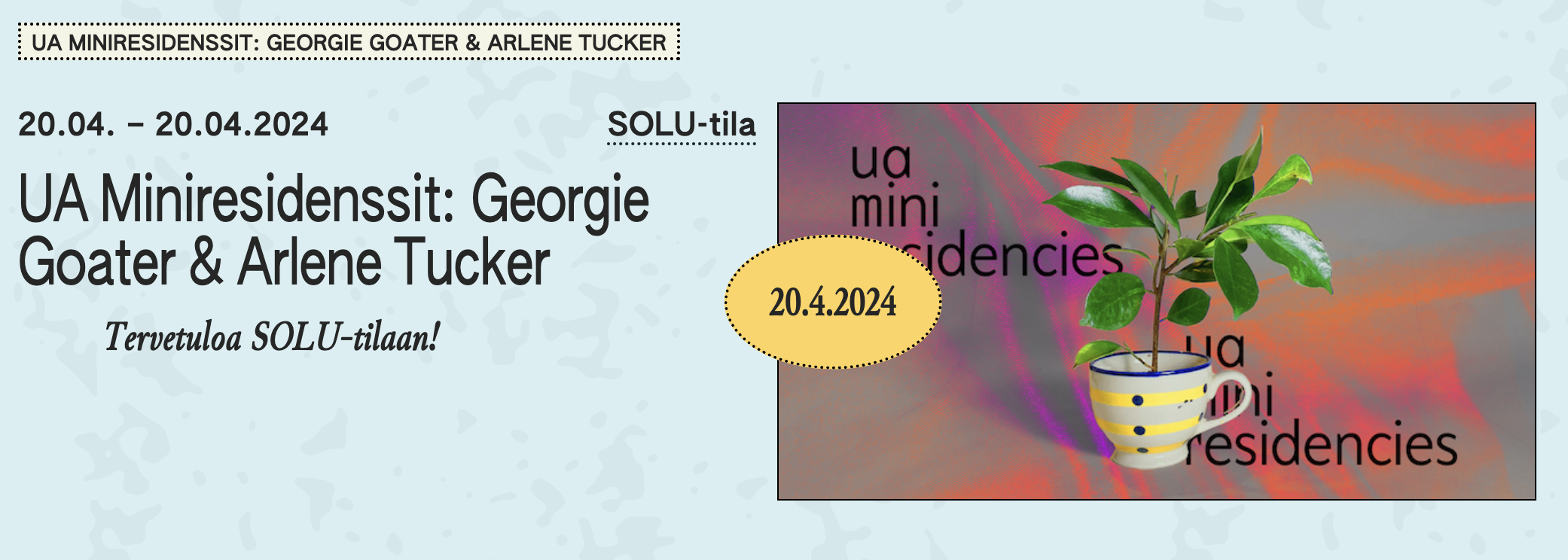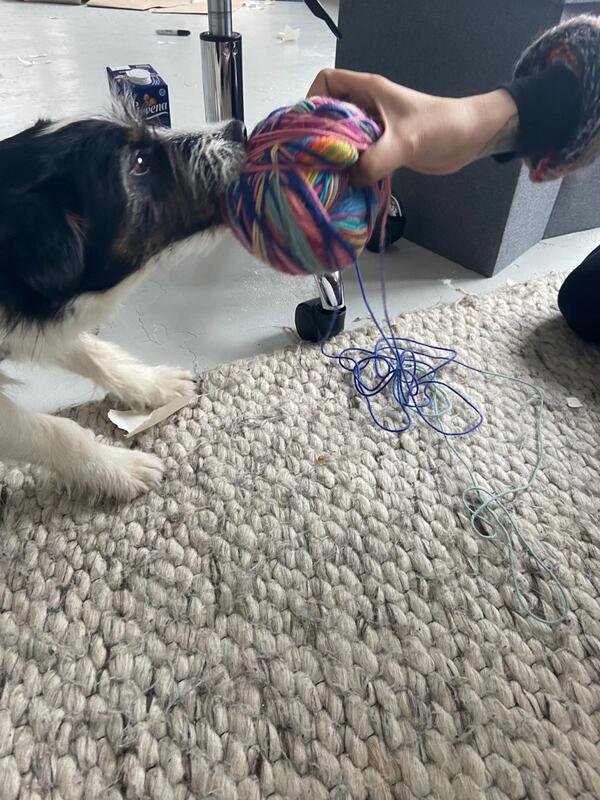|
UA MINIRESIDENSSIT: GEORGIE GOATER & ARLENE TUCKER (siirryt Urbanapa nettisivuun) ENGLISH BELOW Demo, keskustelu, ulostulo – Georgie Goaterin ja Arlene Tuckerin residenssijakso kulminoituu julkiseen tapahtumaan SOLU-tilassa, jossa taiteilijat jakavat prosessiaan ja työtään. Vapaa pääsy! Residenssinsä aikana Georgie ja Arlene tutkivat intersemioottisten käännösten prosesseja erityisesti välineestä liikkeeseen. Miten esimerkiksi visuaalinen teos käännetään liikkuvaan kehoon? Miten voisimme ruumiillistaa tai fyysistää tekstin kääntämisen avulla? Miten ymmärrämme viestin ja miten voisimme koodata, purkaa ja koodata elementtejä kunnioittaen samalla lähdetekstiä? Kääntämällä tulemme tietoisemmiksi siitä, miten vastaanotamme tietoa ja miten haluamme viestiä. Kääntäminen on konkreettinen tapa olla aktivisti ja lisätä tietoisuutta valinnoistamme ja merkityksenantoprosesseistamme. Tuomalla kääntämisen kehoon ymmärrämme ja harjoittelemme sanojen ulkopuolisia viestintätapoja. Lähtökohtamme on, että olemme jatkuvassa käännöksessä. Käytämme apuna Jeremy Mundayn kirjaa ‘Introducing Translation Studies: Theories and Applications’, jotta voimme luoda pisteitä ja leikkimielisiä mutta kriittisiä lähestymistapoja käännöstekniikoihin ja -teorioihin käytännössä kehon kanssa. Koska tiedämme, että yhdessä olemme luonnostaan erilaisia ja suhteellisia, keskitymme tarkastelemaan osallisuutta, saavutettavuutta ja kuulumista, mikä tuo esiin subjektiviteetteja yhteistyössä. Miten voimme piirtää omilla yksilöllisillä kehoillamme, liikkuvuusvälineillämme ja liikeilmaisuillamme? Miten voimme saadaitsemme kuuluviin tanssin ja liikkeen avulla? Arlene on käyttänyt käännöstekniikoita taiteen luomiseen, mutta myös viestinnän ymmärtämiseen vuodesta 2009 lähtien Translation is Dialogue (TID) -työnsä kautta. Suurimmaksi osaksi käännökset ovat olleet visuaalisia ja tekstuaalisia. TID:n kautta Arlene on työskennellyt erilaisten yhteisöjen kanssa ja erilaisten iteraatioiden kautta, kuten Bogotassa, Kolumbiassa, sijaitsevien vanhainkotien asukkaiden kanssa ja vankiloista kärsivien ihmisten kanssa, kuten Free Translation -teoksessa. Georgie on työskennellyt tanssitaiteen parissa vuodesta 2012 lähtien keskittyen esteettömyyteen ja osallisuuteen. Arlene ja Georgie alkoivat miettiä kääntämistekniikoiden tutkimista muilla tavoin kehon kanssa liikkeen ja tanssin avulla, jotta kääntämismatriisiin voitaisiin sisällyttää monipuolista havaintotietoa. Milloin: 20.4.2024 klo 13:45 (tapahtuman kesto n. 90 min) Where: SOLU-tila (Panimokatu 1) Language: englanti & suomi Jos olet kiinnostunut tulemaan tutustumaan kanssamme SOLUssa, ota yhteyttä Arleneen tai Georgieen [email protected] tai [email protected]. Jakotapahtumaan on rajoitetusti paikkoja! Ilmoittauduthan sähköpostitse Georgielle. Ilo, 3,5-vuotias jackrussellinterrieri, tulee mukaan tapahtumaan. Georgie Goater on Aotearoasta kotoisin oleva tanssitaiteilija, joka asuu Helsingissä. Hän on syntynyt ja kasvanut kaksikielisenä Nagoyassa (JP) ja Ōtautahissa (NZ). Hän esiintyy ja koreografioi, fasilitoi työpajoja, kirjoittaa ja tekee yhteistyötä itsenäisesti, Kaaos Companyn (FI) ja Memory as Medium- sekä Body Island -kollektiivien (NZ/FI) kanssa. Työskentely erilaisten ruumiillisten käsitysten kanssa sekä vammaisuuden ja monikulttuurisuuden konteksteissa liikkuminen on luonut perustan jatkuvalle oppimiselle. Arlene Tucker hyödyntää työssään käännösopintoja, visuaalista taidetta, semiotiikka ja feministisiä praktiikoita. ”Taiteeni hahmottuu installaation ja dialogikäytäntöjen varaan. Toteutan työni yhteistyössä yleisön kanssa, minkä myötä voimme jakaa yhdessä perpektiivimme identiteettiin ja kuulumiseen liittyen esimerkiksi muistojen, hiusten ja kirjeiden kirjoittamisen keinoin.” Kun hän kerää ja muotoilee uudelleen identiteettejä ja haastaa samalla normeja, hän kohtaa sukupolvien väliset piilotetut traumansa ja pyrkii myönteiseen muutokseen. Saavutettavuus Pääsisäänkäynnille johtaa 9 porrasta, minkä lisäksi ovelle pääsee rakennuksen vieressä olevan rampin kautta. Etuovi on painava ja siinä on 2cm kynnys. Aulasta pääsee SOLU-tilaan (3. krs) hissillä. Tilassa on suuri wc, johon mahtuu pyörätuolilla. Vessan ovella on 2 cm kynnys. Pyörätuoli mahtuu vain wc-pöntön vasemmalle puolelle (wc-pönttöä päin katsottuna). Vain pöntön vasemmalla puolella (pönttöön päin katsottuna) on kaide, jonka voi nostaa ylös. Tilassa ei ole induktiosilmukkaa. UA Miniresidenssit on UrbanApan uusi konsepti, jonka tarkoituksena on mahdollistaa jatukea taiteilijoiden ja taiteen tekijöiden työskentelyä pehmeällä, kevyellä ja yhteisöllisellätavalla. Ensimmäisessä vaiheessa miniresidenssejä pilotoidaan, mutta pidempiaikainen haave on tarjota tiloja laajemminkin taiteen käyttöön, rikastuttaa ruohonjuuritason työskentelyä ja laajentaa taidealan tukirakenteita. A sharing, a demo, a discussion, an outcome – Georgie Goater’s and Arlene Tucker’s residency period for UA Miniresidencies culminates in a public event in SOLU Space where the artists share some of their process and work. Free admission!
During their residency, Georgie and Arlene will be exploring processes of intersemiotic translations specifically from a medium into movement. For example, how would one translate a visual piece to the moving body? How would we embody or physicalise a text using translation? What is our understanding of the message and how could we code, decode, and encode the elements while honouring the source text? By translating, we become more aware of how we receive information and how we want to communicate. Translation is a concrete way to be an activist and grow more awareness of our choices and meaning-making processes. By bringing translation into the body, we understand and practice modes of communication beyond words. We come from the perspective that we are in a constant state of translating. We will resource Jeremy Munday’s book, ‘Introducing Translation Studies: Theories and Applications’ for creating scores and playful yet critical approaches to translation techniques and theories inpractice with the body. Knowing that together we are inherently diverse and relational, we will have a focused lens on inclusion, accessibility, and belonging, bringing into focus subjectivities within collaboration. How can we draw with our unique embodiments, mobility tools and movement expressions? How can we make ourselves heard through dance and movement? Arlene has been using translation techniques as a mode to create art, but also to betterunderstand what is being communicated since 2009 through Translation is Dialogue (TID). For the most part, the translations have been visual and textual. Through TID, Arlene has been working with various communities and through different iterations such as residents of elderly homes in Bogota, Colombia and through people affected by incarceration as in FreeTranslation. Georgie has been working with dance art with focus on access and inclusion since 2012. Arlene and Georgie started to think about exploring translation techniques in other ways with the body through movement and dance, to include diverse perceptual knowledge into the translative matrix. When: 20 April 2024 at 13:45 (duration approx. 90 minutes) Where: SOLU Space (Panimokatu 1) Language: English & Finnish If you are interested in coming to explore with us at SOLU, please reach out to Arlene or Georgie [email protected] or [email protected]. Places are limited! Email Georgie to register. Please note that Ilo, a 3.5 year old Jack Russell terrier, will be joining the event. Georgie Goater is a dance artist from Aotearoa, based in Helsinki. She was born and grewup bi-lingual in Nagoya (JP) and Ōtautahi (NZ). She performs, choreographs, facilitates workshops, writes, and collaborates as a freelancer, with Kaaos Company (FI) and with collectives Memory as Medium and Body Island (NZ/FI). Working with diverse embodied perceptions across disability and multi-cultural contexts has been a ground for making and constant learning. Arlene Tucker’s socially engaged work utilizes translation studies, visual art, semiotics, and feminist practices. “I realise my art through installation and dialogical practices. Always a co-creation with the public, my work allows us to share perspectives about identity and belonging through different mediums and approaches such as memories, hair, and letter writing.” As she accumulates and reformulates identities whilst challenging norms, she confronts her hidden intergenerational traumas for positive change. Accessibility 9 stairs lead to the building’s front lobby. There is also a ramp next to the building through which you can access the front door. The front door is heavy and has two 2 cm thresholds. From the front lobby, you can take an elevator directly to the SOLU Space (3rd floor). There is a large toilet that can accommodate a wheelchair. The toilet has a 2 cm threshold on the door. A wheelchair can only fit on the left-side (when facing the toilet) of the toilet. There is a handrail only on the left of the toilet (when facing the toilet) which can be lifted up. The space does not have an induction loop. UA Miniresidencies is a series of short residencies that aims to enable and support artists’ and makers’ research or work in progress in a soft, light, and communal way. The long term dream is to alleviate the urgent need for working spaces, enrich the local grassroots scene and create expanded structures of support.
0 Comments
Leave a Reply. |
ContributorsArlene Tucker: author and curator of TID Arch
|





 RSS Feed
RSS Feed
